
Web design has long maintained its relevance in shaping the evolution of the web and how digital users experience websites across devices, whether those are desktop or mobile. The simple function of web design is to create beautiful, engaging, and stunning interfaces that enhance the user experience. It is a true combination of digital art and science.
As web technologies continue to evolve, so does the area of web design. To appreciate how far we’ve come, you can simply look through archives of sites as far back as the early 2000s and contrast them to modern designs. The differences are almost always obvious — at least from a visual aesthetics standpoint. But the “under the hood” differences such as markup structure may be more subtle and nuanced.
To this day, the field of web design continues to grow and change. With that, comes a necessity for most practitioners to stay abreast with the latest trends and topics for website design that have great significance.
In this article, we present 5 web designing projects topics that people continue to take seriously. They are essentially website topics for a project centered on creating stunning web experiences.
1. Responsive Design
The concept of responsive design is not new as of 2019. It’s already at least a 5-years-old topic. However, its increasing importance in the space of web design is what makes it worthy of mention.
But what exactly is responsive design? It is an approach to website creation with a clear goal of making them adapt to various displays and screen sizes. It essentially takes away the notion of a device itself and instead focuses on the screen. From a practical standpoint, responsive design means that whether a website is being viewed from large smart TVs, computer monitors, tablets, or smartphones, it appears in a manner that fits the screen.
Prior to the responsive design movement, achieving such adaptation across screen sizes meant undertaking tedious CSS tweaks aimed specifically for target devices. Thanks to the ever-growing use of responsive design, users nowadays enjoy better experiences online. Businesses also save money by simply spending it on only one design that applies to all screen sizes. At
It may also interest you to know that Google search already factors in the use of responsive design in ranking websites and puts mobile-friendly websites higher.
2. Rich Media Backgrounds
One of the most attractive things about websites is the use of images and videos. Imagine if most of the websites you visit today were simply made up of text content against some white or colored background. That would be an anachronism from world wide web of the early to late 1990s.
Indeed, the aesthetics of rich media continues to grow in use. One creative way it is used in modern web design is wide video backgrounds. This creates an immersive visual effect and can be a powerful way to convey a brand’s message.
3. Animation Effects Using CSS
Having been a reality since the 1990s, the core concept of CSS animations is not novel in itself. But the difference between that period and what obtains today is the broad browser compatibility and adoption of the animation techniques. Today, CSS animation effects can be readily observed in menu bars, side menus, buttons, and other UI elements creating cool transition and pop-and-fade visual effects.
4. Minimalism
Minimalism is a design philosophy that places emphasis on doing or achieving more with less. The minimalist design movement is not native or original to web design. It has its origin in the 1960s American visual arts and is a well-known trend in other design fields such as interior design, fashion, hardware design, etc. But one can’t ignore the fact that is has gained momentum that continues to this year. And, most likely it will continue and emerge as one of the web design trends in 2019. Apple is one of the well-known companies famous in part for its minimalist design language.
5. Parallax Scrolling Effect
Parallax scrolling has fallen in and out of web design trends through the years, but it is currently gaining more popularity in modern web design. It creates a stunning impression of multiple layers of visual elements arranged in a vertical manner.
When a user scrolls down a page, at some point, one seemingly fixed element separates from the other. This creates visual intrigue. Companies like Apple have used this effect in their product pages showcasing their line of laptops and iMacs.
Remember that the above trends and topics can easily change and rapidly lose their popularity since the web design field is marked by dynamism.

